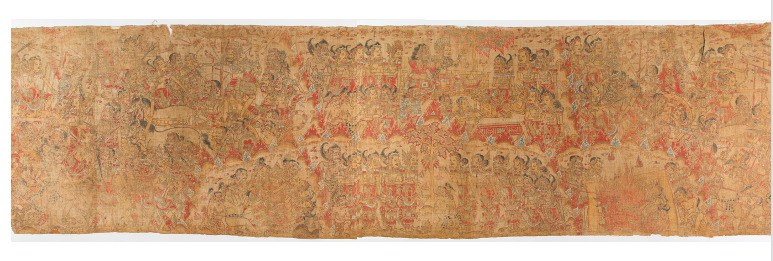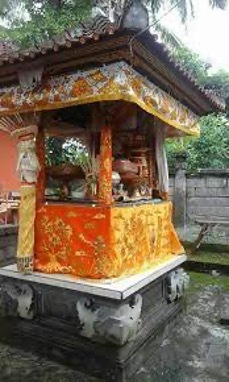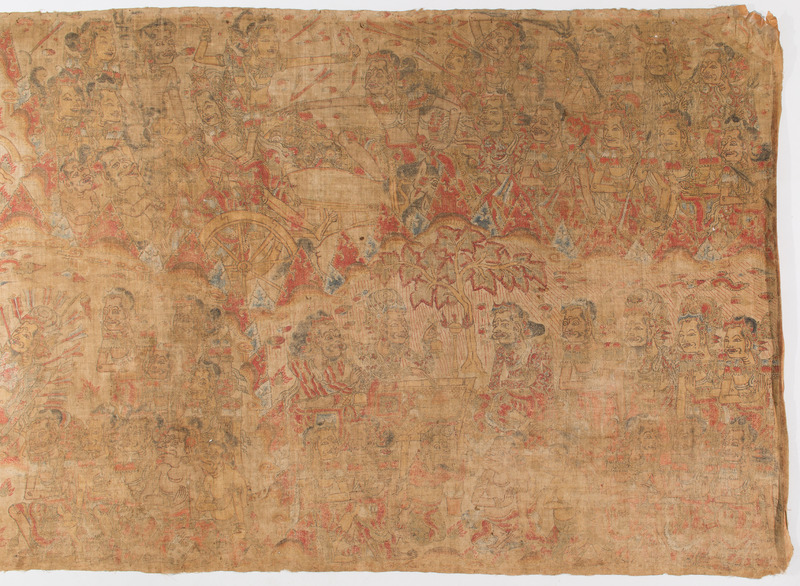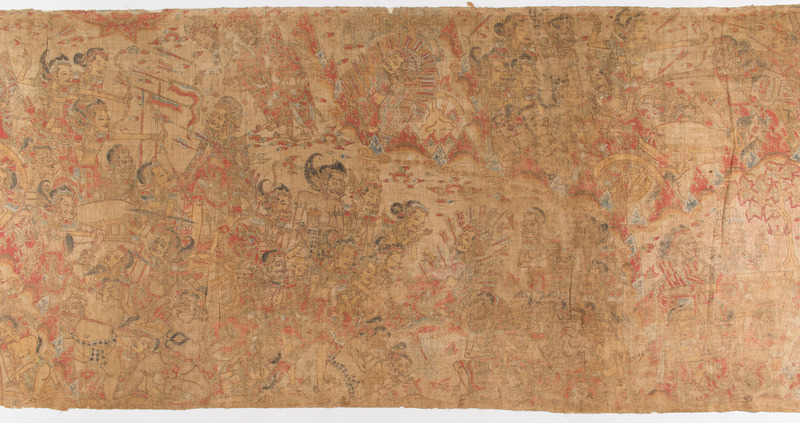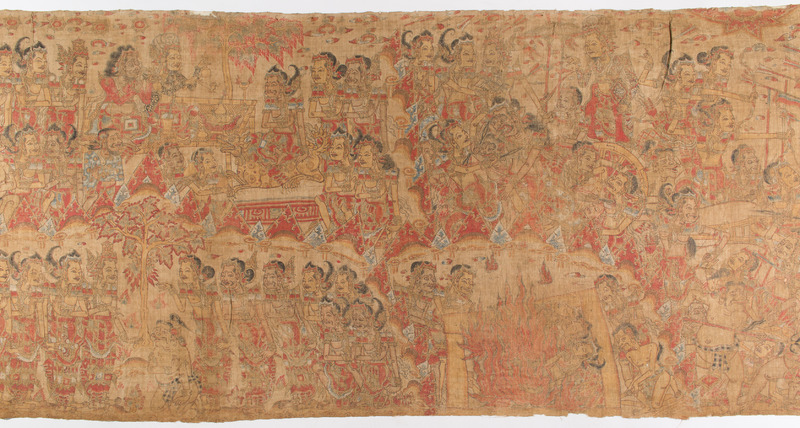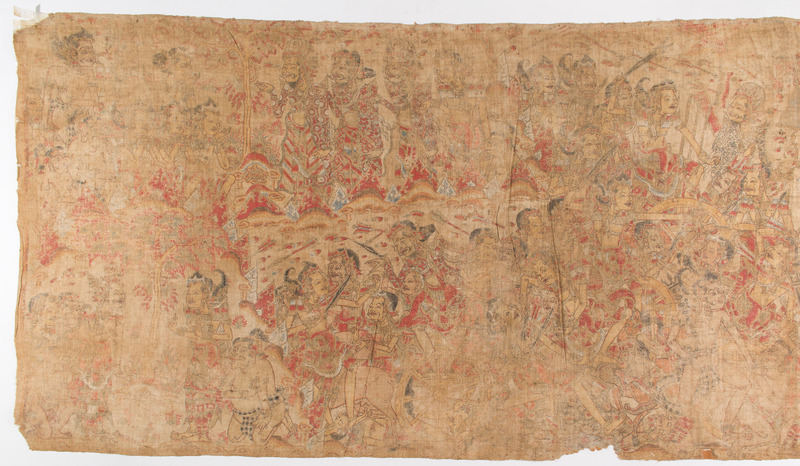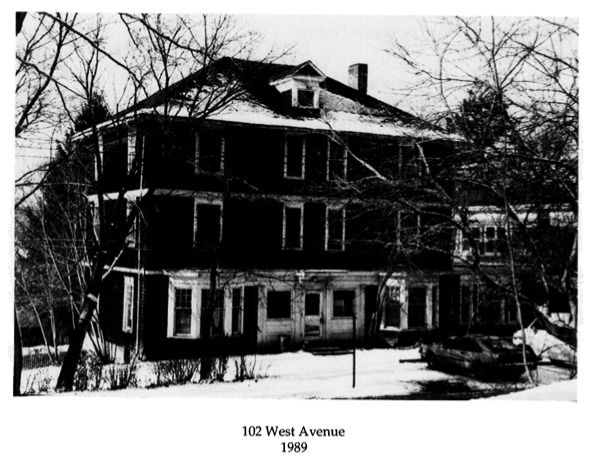Circulating Narratives: The Balinese Ider-Ider at 102 West Avenue
By Astara Light
This hand-painted Balinese textile depicts scenes from the Baratayuda, meaning Great Battle, a complex story that is part of the Mahabharata epic. This artwork, called an ider-ider or pengider-ideran, is made from cotton, ink and pigments and dates from the eighteenth or early nineteenth century. It is a very long painting; measuring 100 cm tall by 700 cm long, or approximately 3.3 by 23 feet. It would traditionally be used to encircle the upper area of a temple. These artworks are a type of “story cloth” in Bali which provide a visual progression through a longer narrative and highlight key scenes within a space. It circulated around various buildings on campus before it became part of the Herbert F. Johnson Museum’s collection in 2007 where it exists today. This unique ider-ider which Kaja McGowan describes as “beautiful and fragile” provided an accompaniment to the Brown Bag talks and other discussions for the Cornell Modern Indonesia Project and the Southeast Asia Program. This work depicts the Baratayuda which is a climactic moment when the two opposing Kuru clans face off on the battleground. Not only does this textile convey a significant Hindu story about the battle between the Pandavas and Kauravas, but its object biography also reflects SEAP’s social history.
Object history and the Great Battle
Balinese ider-ider such as this one are narrative religious artworks displayed in the upper eave section of a temple; they are typically hung inside or outside of spaces with a square floor plan. This particular ider-ider of the Baratayuda might have hung in a square temple where each wall measures approximately 5 to 6 feet, thus dividing the longer narrative cloth and scene into four sub-sections. Although some parts of the eave hanging have faded over the years, many scenes are still clear. The artist(s) applied ink and colored pigments to this long cotton fabric to bring parts of the battle to life. The scenes are rendered in a Kamasan style of painting, also known as “traditional” or “wayang style,” because the figures stylistically resemble shadow puppets. It is a narrative artwork that mirrors wayang kulit or shadow puppet performance through the characters’ bodies, their physical arrangement and formation in the space, as well as the subject matter represented. These technical approaches give the characters and story a tangible presence in a ritual space.
This intricate ider-ider represents the Great Battle which is also known in Indian texts as the Kurukshetra, or “battle of the Kuru clan.” The Baratayuda is a kakawin, which is a poetic retelling of the Mahabharata written in Old Javanese. The battle is a climactic moment from the Mahabharata epic and is preceded by the well-known Bhagavad Gita, a spiritual treatise and conversation between Arjuna and Krishna. The Great Battle thus represents the culmination of a much larger story and generations-long disputes between the Pandava and Kaurava families, who both belong to the Kuru clan.
This long horizontal painting visually narrates multiple scenes. Because the story is highly complex this artwork focuses on some of the more significant moments of the battle. The pengider-ideran has a linear function by showing sequences of events as well as displaying individual moments simultaneously. It visually collapses the perception of time by allowing the viewer to absorb the full story from a distance, or focus more closely on singular scenes. Since the battle itself lasts eighteen days, it is a lengthy story filled with multiple events, long feuds, and the death of significant characters from the larger Mahabharata epic. In the full version of the battle there are many intricate sub-plots and fights that occur.
The previous events and feuds that lead up to the Great Battle provide context for the Bhagavad Gita which is primarily a dialogue between Arjuna and Krishna that notably precedes the violent war shown in this artwork. Arjuna, who leads the Pandava side, becomes overwhelmed by the reality of fighting his relatives and friends who are on the opposing Kaurava side. His charioteer Krishna, who is actually a god, explains Arjuna’s own personal commitments in relation to larger metaphysical and spiritual realities. In order to give Arjuna strength to continue, Krishna argues that there are other issues at stake beyond his life and the particular battle that is about to take place. Thus, there are philosophical messages and questions that pervade the battle itself.
Ider-ider are generally read from right to left, and although not every scene in this artwork is clear, there are several moments from the Baratayuda that can be discerned. Starting with the rightmost section of the full ider-ider painting, shown in the image above, the first scene depicts a conference at the Pandawa camp that takes place before the battle begins. Then in the upper left register of Figure 1 the five Pandava brothers appear together along with two twalen or clowns. In this figure Arjuna and Krishna are shown riding in a chariot. Arjuna is usually represented wearing a warrior headdress, which resembles a shrimp-tail shape, and holding a bow and arrow, since he is famous for his archery skills. Kaja McGowan describes another visual marker for identifying characters in traditional Balinese paintings: “It is always difficult to distinguish the individual characters. The heroes, however, usually are always depicted in the foreground, and always use bows and arrows or clubs (and not swords and spears).”
This section of the ider-ider (Figure 2) likely represents the death of Bhisma, who was fighting on the Kaurava side. He is, however, a friend and family member to the Pandavas as well. In typical narratives of the battle Bhisma was struck by arrows from Arjuna’s bow and he lies there, slowly dying as a witness during the entire Great Battle. Because he was a highly respected warrior, people on both sides of the Kuru clan, Pandava and Kaurava alike, stopped during the battle to mourn by his side. This section likely represents Bhisma mortally wounded and lying on a deathbed of arrows since many figures are shown encircle and watch over him.
Also in in the uppermost section of Figure 2, the death of Karna is likely depicted. Karna is actually the half-brother of the Pandavas, but he fights on the Kaurava side because he was raised by that clan. In what I find to be one of the most unsettling parts of the battle, Karna is killed by Arjuna when his chariot wheel gets stuck in the mud and he is at a disadvantage. Although Arjuna initially hesitated to attack him then, he remembered multiple times when Karna had sided with the Kauravas or disrespected the Pandavas in different ways. Thinking of this, Arjuna chose to attack Karna during this vulnerable moment and he dies next to his chariot. I hypothesize that this scene represents Karna’s death because the figure is shown directly next to a wheel and has been struck by multiple arrows, indicating that he was killed by Arjuna.
McGowan describes a significant moment in this story (Figure 3) and some of the visual approaches and subject matter that help to distinguish Balinese representations of the Great Battle story in the Mahabharata from other versions of the famous Indian epic:
For me, always the key visual marker for the Bharatayudha as depicted in Balinese Kamasan painting can be found in the lower register, where you see King Wirata’s two younger sons who are killed at the outset of the Great War: Sangka killed by Drona and Utara killed by Salia. (…) In the lower register, the brothers are depicted being cremated at night. I would suggest that the emphasis on this personal royal loss, depicted ritually, was intended on a shrine, to mirror similar rituals of bereavement for Balinese.
Although the narrative in Figure 4 is difficult to discern, in the upper and lower registers of the right portion of this image the five Pandava brothers are lined up one after another, perhaps for a ceremony or another conference. Although it is quite faded, I propose that the lower left section depicts the last major duel, which occurs between Bhima, one of the Pandavas, and Duryodhana who is considered the main villain and instigator of the conflict between the Kuru clans. Bhima is usually shown as the largest of the five Pandava brothers and he is known for fighting with a club. In shadow puppet and traditional painting representations, Bhima has large rounded eyes, he wears a warrior headdress (resembling a shrimp tail), and wears a black and white checkered sarong or cloth wrapped around his lower body. In the Great Battle, Duryodhana’s final and mortal duel is with one of the Pandava brothers, and he requests to fight Bhima and chooses a club as the main weapon.
One scene shown toward the end of this painting (Figure 5) likely represents a final and tragic loss after Duryodhana was killed by Bhima. In anger over Duryodhana’s death, his friend Ashwatthama leads other warriors on the Kaurava side to attack and kill fighters and civilians who are sleeping at night in the Pandava camp. Since each day of battle would end with a truce at sunset, this was another betrayal of a battle “code” and was a devastating loss for the Pandavas. Following this brutal scene, in the uppermost left register, the five Pandavas appear standing together in front of a tree with other characters lined up and facing them on the other side. This formation suggests they are meeting to grieve over the losses and consequences after the battle has concluded. This scene also marks a meditative moment where the Pandava clan reflects on their future responsibilities as rulers.
This Balinese ider-ider dynamically represents characters in the midst of fighting— chaotically tangled together—with weapons flying and moving in all different directions. In some sections characters have fallen and died during the course of the battle. The style recalls shadow puppet theater in multiple ways, one example is the use of trees throughout the painting to mark shifts or sections of the story. There are also scenes that suggest moments of contemplation, which reminds the viewer of the spiritual and moral questions pervading all the destruction shown. This ider-ider is a stunning example of Kamasan or traditional painting in Bali that links to wayang kulit performance.
Circuitous routes
This painting has moved across multiple contexts in its trajectory from Bali to the Johnson Museum at Cornell. Kaja McGowan explained that the ider-ider most likely came from the Kamasan area of Bali and that it was given to Claire Holt by her friend Bobby Morcer-Bruns, who was the head of the KPM, a Dutch shipping company. The KPM (Koninklijke Paketvaart-Maatschappij) was established 1924 and had a weekly steamship route between Bali and Batavia (now Jakarta), Singapore, Semarang, Surabaya, and Makassar. McGowan describes more of this history, which can be traced in letters between Bobby and Claire in the Claire Holt collection at Cornell: “the first tourists were from the Dutch colonial administration. Bobby was on board this ship when Claire Holt arrived in 1935 with Gela Archipenko. At the time, the two women were on route to Walter Spies’ house, and according to the story both found Spies accompanying the guests on the piano on the KPM ship.” Although there is not specific information as to where and how Bobby Morcer-Bruns acquired this Balinese ider-ider, it likely originated from a temple where it would have had a ritual function.
Holt gave this ider-ider to the 102 West Avenue building to be used in the meeting space. While it is possible that Claire Holt also gifted this ider-ider to her friend Ben Anderson, there is not clear evidence to indicate this. The 102 West Avenue building served SEAP and the Cornell Modern Indonesia Project (CMIP). The meeting space at 102 was used for Brown Bag lectures on Thursdays which are today known as the Ronald and Janette Gatty talks. Initially, the ider-ider was hung in a large meeting room where lectures and other events were held. The ider-ider partially encircled the gathering space where early discussions of revolution, power, and politics took place. As McGowan described during our discussion: “There’s a reason why Ben Anderson writes about power, and there’s a reason why the theme of power and prowess were generated very early on at Cornell.”
This meeting room at 102 had a similar function as the Kahin Center’s main lecture room where presentations and conversations about Southeast Asian studies occur. Audrey Kahin described seeing the ider-ider hung around the long and short wall of the meeting room where Brown Bag sessions happened. In a photo identified by Kahin and featured in volume 48 of SEAP’s Indonesia Journal, Ruth McVey can be seen giving a talk in that large room and a corner of the leftmost section of the ider-ider is visible.
Stanley O’Connor also recounted memories of the 102 West Avenue building, which was located behind the law school, near the Jewish fraternity and other fraternity buildings. 102 was the original building for the first CMIP and SEAP cohorts. It was like a home and provided a lively place with lots of storytelling. The ider-ider provided an accompaniment to the conversations that occurred at 102 West Avenue in the 1950 through 1970’s, a particularly pivotal time for SEAP and for scholarship about Southeast Asia.
Martin Hatch described the dynamic at 102 West Avenue when he came in 1970 as a grad student in Southeast Asian Studies and Music. He said that on the lower level of the building George Kahin and Ben Anderson had their offices and, much like at the Kahin center, upstairs there were offices for graduate students. The researchers there held a shared focus on Indonesia and Southeast Asia, which provided a sense of community. On the layout at 102, Hatch said that it: “brought a kind of familiarity in the best sense of the word… People would talk to each other and they would be in contact with two of the most vigorous scholars of the time, George and Ben, if something came up. And in those years something always came up, in the sense that things were always happening in Indonesia and Southeast Asia.” And regarding the experience of graduate students and other researchers at 102, Hatch described the social environment as follows:
Talking at the experiential level, well it was a way of setting a different mood and stage for these talks. In fact, the whole building 102 West Avenue had that feel to it. Because it was not meant to be a formal place where scholars were supposed to sit at their desks and write… It was (also) a place for interactions, for people to talk about the kind of work they were doing. In the modern Indonesia project, it featured an interest in having people think comprehensively (and) holistically about what Indonesia was. There were pictures hanging everywhere of people’s experiences.
In a recent essay, Ajan Thak Chaloemtiarana explains how the 102 West Avenue building connects to the history of the Brown Bag talks:
“The first BB lecture was held on Thursday, March 5th at 12:15pm at 102 West Avenue. The Thursday lunch hour thus became a tradition since 1959. (…) When I arrived in 1968, the Brown Bag lectures at 102 West were unrivalled on campus as a “must attend” and “standing-room only” events. Because of the US involvement in Southeast Asia and the anti-Vietnam War movement, interest in the region peaked from the mid-1960’s until the end of the 1970’s.” (5-6, SEAP Bulletin)
In our conversation with Martin Hatch, he also described the role of 102 West Avenue and the interconnectedness of Indonesian art forms:
I’m trying to embed art into the fabric of Southeast Asian studies. Not in a way that says ‘there’s Southeast Asian studies and one of the studies is art.’ I’m saying that actually they’re interwoven, at least in the case of Indonesia for me. And of course music is an art form and that’s been the case for me too. 102 was a place where scholarship and engagement were intertwined. It just seemed like a home. Art is life, and 102 is like a painting or a vision. 102 was a work of art, but it was a dynamic, ‘living art;’ it affected lots of people. There was a kind of dance going on every day as people were dancing around various topics.
The vibrant memories of so many SEAP faculty suggests that this Balinese ider-ider and the 102 West Avenue space share a theme of dynamic interactions between various players. For the SEAP community at 102, scholars met for discussions that centered on politics and revolution at a global scape. In this sense, the battle between the Pandavas and Kauravas, which marks a kind of regime change in the Mahabharata epic, provided germane company to these conversations.
Kaja McGowan explained this artwork’s trajectory across the Cornell campus and how it resided in different spaces after the 102 building closed. When 102 was torn down the ider-ider was stored at the Kahin Center where it was likely kept along with Claire Holt’s letters and other archival materials. When these letters became part of the Echols Collection the ider-ider moved with them as part of the Holt collection. The “narrative” function of objects like this ider-ider may also explain why it was initially classified with Holt’s letters and other papers. Ider-ider could be classified as “textual” objects along with Balinese lontar and calendars which share a blurring between “image” and “text” (Mitchell) because of their function.
One day, the Echols Collection librarian Greg Green found this Balinese ider-ider depicting the Baratayuda wrapped up in his office at Uris Library. He asked Kaja McGowan to look at it, and she recognized it as the same painting that had hung up for so many years at 102 West Avenue. Although this beautiful ider-ider is a challenging artwork to maintain given its “unwieldly size and fragile condition,” according to McGowan, it was recognized as an important work and accepted into the Herbert F. Johnson Museum’s collection.
This painting’s biography and its reception illustrate a critical shift in how art is classified in different spaces. Shortly after the exhibition “Story Cloths of Bali” in 2006, which highlighted other Balinese narrative textiles, this ider-ider was transferred from the Echol’s collection at the library to the Johnson Museum’s permanent collection in 2007. This painting has journeyed through different locations and been viewed and stored in a range of contexts, from a temple (pura) in Bali, to the walls of a lecture room, and, most recently in the physical exhibition titled “(Re)Collecting: Southeast Asian Art at Cornell” held at the Herbert F. Johnson Museum from August through December, 2021. And in a way, the ider-ider’s story mirrors the circuitous routes that often shape the research journeys of individuals connected to SEAP.
Sources
The majority of information in this essay is from email, phone, and Zoom conversations with Kaja McGowan, Stanley O’Connor, Audrey Kahin, Martin Hatch and Ellen Avril in 2020. A very special thanks to these individuals for their time and contributions to this topic.
Thak Chaloemtiarana. “From Luncheon Lectures to the Brown Bag to the Gatty Lecture Series 1950-2021.” Southeast Asia Program Bulletin. Cornell University, Fall 2021.
George McT. Kahin. “Cornell's Modern Indonesia Project.” Indonesia. Vol. 48. 1-25. Published: Cornell University Southeast Asia Program, 1989-10.
Shanta Rameshwar Rao. The Mahabharata. Illustrated by Badri Narayan. Orient Longman Limited, 1988.
